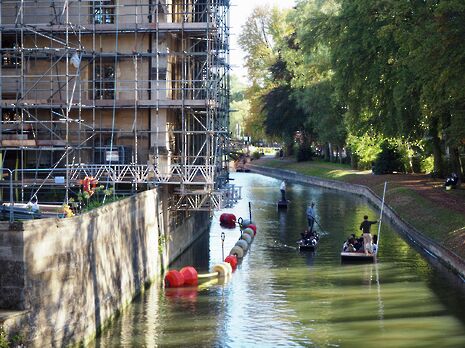Waste produced by the University more than doubled in 2016/17, according to report
The University has attributed this increase to the large amounts of construction work that have taken place this year

A report released by the Higher Education Statistics Agency (HESA) earlier this year has revealed that the University of Cambridge produced 19,849 tonnes of waste during the 2016/17 academic year, more than doubling the amount produced the year before.
The amount of waste saw a 131% increase from 2015/2016, during which 8,582 tonnes of waste were produced.
This figure means that the University produced 994.7 kilograms of waste per student last year, more than double the average for UK Universities. To compare, Anglia Ruskin University’s waste produced per student was just 240 kilograms.
The University also failed to achieve its target of recycling at least 95% of total waste produced by 2016/17.
Joanna Chamberlain, the head of the university’s Environment and Energy team, attributed the rise to “an increase in the number of capital projects”, explaining that in 2016/17 the waste mass from “other works”, particularly construction, increased by 227%.
These construction projects include the North West Cambridge Development, a 150 hectare site which intends to develop homes and facilities for post-graduate students and staff of the University.
Non-residential waste mass – waste from operational university activity including teaching and research – in contrast, decreased by 16% in the 2016/17 year from the previous year, and, despite its increase in total waste production, the University has also increased the amount of waste that is recycled
Between the 2015/16 and 2016/17 academic years, Chamberlain explained, the University’s overall recycling rate increased from 70% to 83%, whilst percentages of waste sent to landfill decreased from 29% in 2015/16 to 11% in 2016/17.
Particularly for operational waste, an improvement has been seen in the amount that is recycled, with 2016/17 marking the first year that the majority of this kind of waste was not sent to landfill. The University’s report explained that this is because non-recyclable waste is now transformed to ‘refuse-derived fuel’, to be used for energy.
The recycling rate for construction projects, however, decreased this year from 92% to 87%. It is not clear, however, what the recycling rates are for specific projects such as the North West Cambridge development.
When contacted, North West Cambridge Development said that they did not intend to add to the University’s previous comments on the matter of waste produced in their construction.
However, the University’s Environment and Energy team did state that all projects greater than £300,000 (the North West Cambridge Development is an estimated £1bn investment) require a Resource Management Plan to cover both waste created on-site and waste made in manufacture or fabrication off-site.
When asked what action the University was intending to take to reduce the amount of waste produced, Chamberlain described activities such as “providing increased recycling options”, a “bin busting audit” by students to gain further information on what goes in each bin, and “communication and engagement activity to encourage staff and students to put the right waste in the right bin.”
The University’s 2018 Environment and Sustainability Report said that they had put “significant effort” into improving their recording of waste data, which would help them “better manage and control their waste outputs.” However, the report reasserted that is was the large scale construction work that caused the increase in waste produced.
Having failed to meet their recycling target, the University currently intend to send zero non-hazardous waste to landfill by 2020. While the amount disposed of in this way did decrease in the 2016/17 academic year, the overall increase in waste produced may make it difficult to achieve this goal.
 News / Downing investigates ‘mysterious’ underground burial vault 29 December 2025
News / Downing investigates ‘mysterious’ underground burial vault 29 December 2025 News / Unions protest handling of redundancies at Epidemiology Unit30 December 2025
News / Unions protest handling of redundancies at Epidemiology Unit30 December 2025 Lifestyle / Ask Auntie Alice29 December 2025
Lifestyle / Ask Auntie Alice29 December 2025 Features / ‘Treated like we’re incompetent’: ents officers on college micromanagement30 December 2025
Features / ‘Treated like we’re incompetent’: ents officers on college micromanagement30 December 2025 Science / Astronomical events to look out for over the break29 December 2025
Science / Astronomical events to look out for over the break29 December 2025










